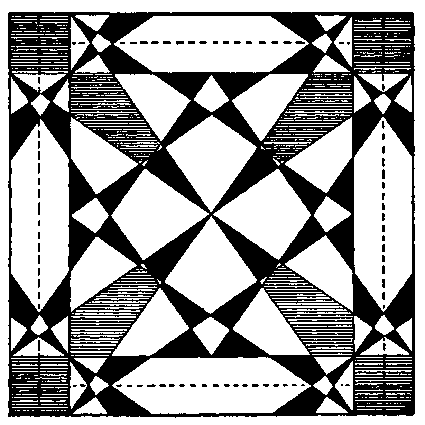Musical Proportions at the Basis of Systems of Architectural
Proportions both Ancient and Modern
Jay Kappraff, Professor of Mathematics
New Jersey Institute of Technology, Newark, New Jersey, USA
 Throughout
the history of architecture there has been a quest for a system
of proportions that would facilitate the technical and aesthetic
requirements of a design. Such a system would have to ensure a
repetition of a few key ratios throughout the design, have additive
properties that enable the whole to equal the sum of its parts,
and be computationally tractable--in other words, to be adaptable
to the architect's technical means. The repetition of ratios enables
a design to exhibit a sense of unity and harmony of its parts.
Additive properties enable the whole to equal the sum of its parts
in a variety of different ways, giving the designer flexibility
to choose a design that offers the greatest aesthetic appeal while
satisfying the practical considerations of the design. Architects
and designers are most comfortable within the realm of integers,
so any system based on irrational dimensions or incommensurable
proportions should also be expressible in terms of integers to
make it computationally acceptable
Throughout
the history of architecture there has been a quest for a system
of proportions that would facilitate the technical and aesthetic
requirements of a design. Such a system would have to ensure a
repetition of a few key ratios throughout the design, have additive
properties that enable the whole to equal the sum of its parts,
and be computationally tractable--in other words, to be adaptable
to the architect's technical means. The repetition of ratios enables
a design to exhibit a sense of unity and harmony of its parts.
Additive properties enable the whole to equal the sum of its parts
in a variety of different ways, giving the designer flexibility
to choose a design that offers the greatest aesthetic appeal while
satisfying the practical considerations of the design. Architects
and designers are most comfortable within the realm of integers,
so any system based on irrational dimensions or incommensurable
proportions should also be expressible in terms of integers to
make it computationally acceptable
In his book The Theory of Proportion
in Architecture, P.H. Scholfield discusses three systems
of architectural proportion that meet these requirements: the
system of musical proportions used during the Renaissance developed
by Leon Battista Alberti, a system used during Roman times, and
the Modulor of the twentieth-century architect, Le Corbusier.
All of these systems draw upon identical mathematical notions
already present in the system of musical proportions. While the
Roman system is based on the irrational numbers root-2 and theta=1+
root-2, the Modulor is based on the Golden Mean, phi=(1+
root-5)/2. Both of these systems can also be approximated arbitrarily
closely (asymptotically) by integer series, and these integer
series can be used to implement the system with negligible error.
At the basis of the Roman system is the "law of repetition
of ratios" and the geometrical construction known as the
"Sacred Cut." An analysis of the Medici Chapel illustrates
that both the law of repetition and the Sacred Cut are geometric
expressions of the additive properties of the Roman systems and
ensure the presence of musical proportions in a design. The discussion
concludes with Ezra Ehrenkrantz's system of "modular coordination"
based on both musical proportions of Alberti and Fibonacci numbers.
Order Nexus: Architecture and Mathematics
abstract
index | Previous
abstract | Next abstract | E-mail Jay Kappraff | Nexus Network
Journal Homepage
 Throughout
the history of architecture there has been a quest for a system
of proportions that would facilitate the technical and aesthetic
requirements of a design. Such a system would have to ensure a
repetition of a few key ratios throughout the design, have additive
properties that enable the whole to equal the sum of its parts,
and be computationally tractable--in other words, to be adaptable
to the architect's technical means. The repetition of ratios enables
a design to exhibit a sense of unity and harmony of its parts.
Additive properties enable the whole to equal the sum of its parts
in a variety of different ways, giving the designer flexibility
to choose a design that offers the greatest aesthetic appeal while
satisfying the practical considerations of the design. Architects
and designers are most comfortable within the realm of integers,
so any system based on irrational dimensions or incommensurable
proportions should also be expressible in terms of integers to
make it computationally acceptable
Throughout
the history of architecture there has been a quest for a system
of proportions that would facilitate the technical and aesthetic
requirements of a design. Such a system would have to ensure a
repetition of a few key ratios throughout the design, have additive
properties that enable the whole to equal the sum of its parts,
and be computationally tractable--in other words, to be adaptable
to the architect's technical means. The repetition of ratios enables
a design to exhibit a sense of unity and harmony of its parts.
Additive properties enable the whole to equal the sum of its parts
in a variety of different ways, giving the designer flexibility
to choose a design that offers the greatest aesthetic appeal while
satisfying the practical considerations of the design. Architects
and designers are most comfortable within the realm of integers,
so any system based on irrational dimensions or incommensurable
proportions should also be expressible in terms of integers to
make it computationally acceptable